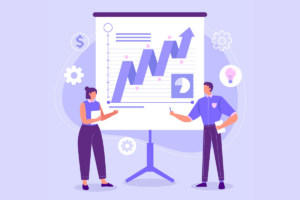Sales forecasting software can be one of the most important tools in your sales toolkit. The reports created from this software can show you targets vs. achieved vs. potential sales, and so much more. This information is important for managers to create the most accurate forecasts. Sales forecasting technology aims to answer questions like: What amount of revenue can we expect? Can you accomplish this by a salesperson, region, or account(s)? How did actual sales compare to expected? Why did/didn’t these numbers match? What method creates the most accurate forecast? These questions are extremely important in order to plan what is next for your company and where you are going.
What is a Sales Forecasting Software?
Sales forecasting software includes templates to ultimately help your team forecast more accurately based on proven statistics. These templates run statistical analysis on historical data and reports. Users program templates with “assumptions” to account for behaviour and historical market conditions. Forecasting is a process for self-assessment, market assessments, and reflections on sales teams and individuals. To forecast accurately, detailed business records, market conditions, and other factors (template specific) are often needed.
Below, we’ve put together a list of the 7 best sales forecasting software to assist you in choosing one. Not in any particular order. We have no affiliation and do not receive a commission from any of these companies.
Our Picks for Best Sales Forecasting Software
1. Anaplan

Anaplan is taking connected planning to new heights. Their platform is powered by proprietary technology which is purpose-built. With the ability for connected planning, enables dynamic and collaborative planning. This gives global enterprises a solution to connect people and data giving real-time planning and decision making. You are able to better understand when you will need what supplies, thus understanding when and where sales are coming from so you are ready.
2. IBM Planning Analytics

IBM Planning Analytics is powered by IBM technology and delivers agility and accuracy. This modelling brings faster insights and allows for a quicker rollout. Allowing companies to save in labour and overall cost. Also, allowing for the adoption of Microsoft Excel interface for faster adoption. Your team is able to collaborate across the channel for a 360-degree view of data for a more trusted view of the win/loss trends and performance metrics to increase revenue.
3. InsightSquared Sales Analytics

InsightSquared is a sales analytics and development tool that helps support you and your team in demand generation. This program is designed to help provide insights on various aspects of your business. These aspects include; your sales process, closing rates, pipeline and revenue forecasting, KPIs, and markets. Through these different measurements, InsightSquared can help you and your team approach your market with confidence. Allowing your different departments to understand their individual forecasts and not just an overall forecast for the business, is important as it becomes immediately relevant to them.
4. Sales Cloud from Salesforce

With Sales Cloud by Salesforce, forecasting has ever been easier or more accurate. Get in-line editing, override visibility, multi-currency support, and real-time views into your team forecasts. With the insights you need to not only forecast accurately, but also to make smarter decisions, you have all the necessary information in one location. Dig deeper with real-time reports that anyone can create on sales, service, custom apps, and 3rd party data to ensure a full view of your business.
5. Workday Adaptive Planning

Forecasting is at the forefront of Workday Adaptive Planning Business Planning Cloud. This software lets you create models of almost every facet of your business. Allowing you to not only forecast sales but also budget, workforce, SaaS, and more. Financial modelling can be scheduled around your fiscal year, funding schedule, revenue recognition schedule and more, giving you a clear financial view of your business. These forecasts can also be broken down into any segment of your business, whether they are department, program, or business unit specific.
6. Prophix Software

Forecasting is a crucial part of any business, but it can be difficult to get right. Often manually created forecasts are out of date not long after you make them because if they are not regularly updated to meet your business climate, they will be missing information. With accurate and regularly updating automated forecasts you are able to not only see how you are doing at this moment but in the future as well. As your business grows it is constantly changing, as is the market. This requires a tool that accounts for this changing landscape and does it automatically so that you always have the most accurate and relevant information available.
7. Centage Planning Maestro

Centage is a cloud-based planning and analytics platform that aims to deliver year-round financial intelligence, budgeting, forecasting and reporting analytics. They deliver intelligence that is crucial to large enterprises but at a price point suited for small to medium-sized businesses. With a direct line of sight into your organizations financial health, you are able to make fast decisions and react quickly to the changing markets.
How To Pick A Sales Forecasting Software
Now, what does this mean for you, the reader? There are plenty of tools that help your team collaborate and work with a top-down solution allowing for a more clear view of your business and plan more accurately. Further, it is important to understand what aspects of your business you are hoping to forecast and how you would like to use the tool. As forecasting is extremely important to be accurate, it is ever more important to pick a tool that is as accurate as possible for you.
Some tools are owned by larger companies. If you alread invest in their suite it can be beneficial to invest in these tools for ease of integration. Also, some tools allow for multiple users to plan and forecast their own team or department. This can be beneficial to larger teams that want managers to plan their departments and have multiple views that build to an overall view. For larger teams, this can be essential where smaller businesses might simply need an overall view. Understanding what needs you are trying to meet is important before you invest your time and money in a tool.
 Identify
Identify Personalize
Personalize Benchmark
Benchmark Agencies
Agencies Integrations
Integrations Case Studies
Case Studies Use Cases
Use Cases Blog
Blog Resources
Resources









